
THE ARMORY SHOW, BOOTH S4 | JAVITS CENTER | NEW YORK (9 - 11 SEPTEMBER 2022) Solo presentation by Mohamed Ahmed Ibrahim at The Armory Show
Sep 09, 2022 EVENT, Art Event

The presentation provides a glimpse into Ibrahim’s practice, comprising recent paintings, papier-mache and collage works, against the backdrop of an immersive installation of his seminal Lines drawings. It runs concurrently with Mohamed Ahmed Ibrahim: Between Sunrise and Sunset, the artist’s major installation for The National Pavilion of the United Arab Emirates at the 59th Venice Biennale. The exhibition, on view at Arsenale – Sale d’Armi in Venice until 27 November 2022, is a hall-filling piece comprising 128 abstract and organic elements in his signature medium of papier-mache.
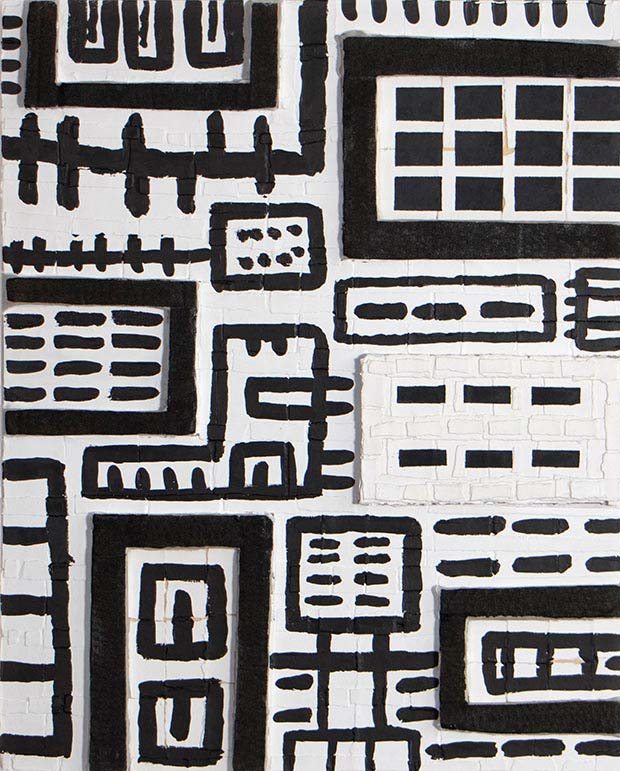 Mohamed Ahmed Ibrahim, Untitled, 2016, Paper assemblage, 61 x 49.5 cm / Courtesy of the artist and Lawrie Shabibi
Mohamed Ahmed Ibrahim, Untitled, 2016, Paper assemblage, 61 x 49.5 cm / Courtesy of the artist and Lawrie Shabibi
brahim’s intensely experimental and prolific art practice conveys his deep fascination with memory, imagery and ways of seeing and experiencing the environment, coming from both his personal experiences and the kind of innate memory found in our DNA, which he describes as a ‘primitive urge.’ His work resonates with his deep connection to the natural environment of Khorfakkan, a rambling coastal town on the Gulf of Oman, enclosed on one side by the rocky Hajar Mountains and the other by the sea. His paintings and drawings are imbued with his form of language - inscriptions, lines and abstract forms that are reminiscent of ancient scripts - marking time and memory through meditative repetition.
For The Armory Show, Ibrahim recreates his immersive installation, originally presented as part of a group exhibition at the Kunstcentrum Sittard in the Netherlands in 1995 – his debut in Europe. Black typographic marks on the paper line the walls, from floor to ceiling, filling the entire space. Ibrahim’s fascination with the line traces back to his early childhood memories of markings on the gate walls of homes in his town. Single lines were drawn in charcoal to indicate the number of water bottles delivered. Leaving an imprint on his memory, these repeated lines – some reminiscent of ancient scripts, road marks or city skylines - have become the backbone of Ibrahim’s practice.
 Mohamed Ahmed Ibrahim, Untitled, 2022 Acrylic on canvas, 152 x 183 cm / Courtesy of the artist and Lawrie Shabibi / Photo by John Smith of Black Smith Photography
Mohamed Ahmed Ibrahim, Untitled, 2022 Acrylic on canvas, 152 x 183 cm / Courtesy of the artist and Lawrie Shabibi / Photo by John Smith of Black Smith Photography
 Mohamed Ahmed Ibrahim, Untitled, 2022 Acrylic on canvas 183 x 152 cm / Courtesy of the artist and Lawrie Shabibi / Photo by John Smith of Black Smith Photography
Mohamed Ahmed Ibrahim, Untitled, 2022 Acrylic on canvas 183 x 152 cm / Courtesy of the artist and Lawrie Shabibi / Photo by John Smith of Black Smith Photography
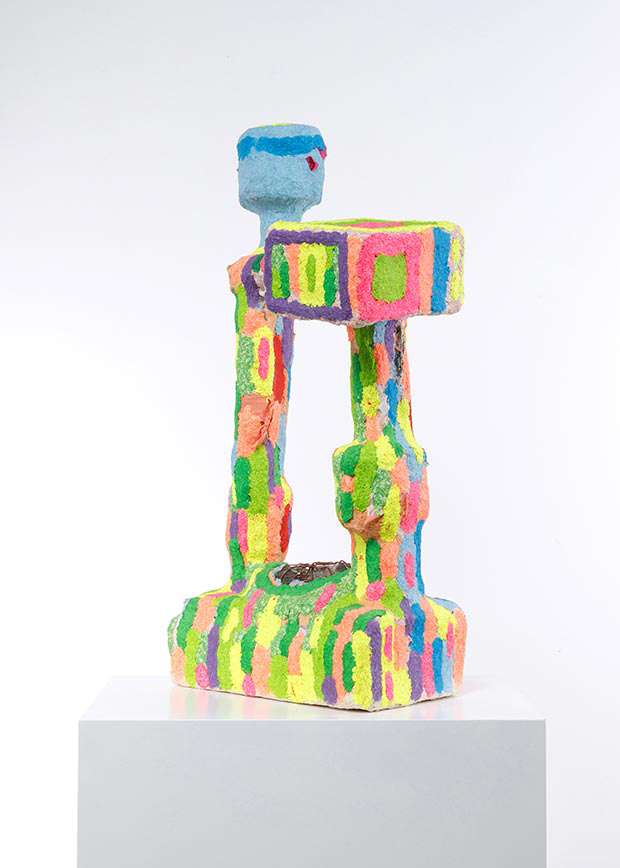 Mohamed Ahmed Ibrahim, Bouquet 2, 2018 Cardboard boxes, papier-mache 83 x 40 x 26 cm / Courtesy of the artist and Lawrie Shabibi / Photo by Ismael Noor of Seeing Things
Mohamed Ahmed Ibrahim, Bouquet 2, 2018 Cardboard boxes, papier-mache 83 x 40 x 26 cm / Courtesy of the artist and Lawrie Shabibi / Photo by Ismael Noor of Seeing Things
Against the monochromatic backdrop of lines, a series of black and white papier-mache wall sculptures create the sensation of the marks materializing three-dimensionally from the walls. Part painting, part sculpture, Ibrahim’s sculptural experimentations have a primordial quality to them – a grouping of hand-moulded oblong shapes wedged with blocks of a card, bodies of paper hanging from strings or crushed into the shapes. Similarly, in his collages and assemblages, cut-out paper and card are arranged to create various compositions of the same repetitive black lines. At times minimal, at times complex, the works play with notions of multiplicity and division.
In parallel to these, Ibrahim presents four recent paintings, a continuation of his Symbols body of work. Large-scale, bright and textured, his canvases are populated with his emblematic abstract notations - an innate, instinctive script, meditatively repeated in an obsessive yet gentle manner, reconfigured and recoloured, much as the vertical marks in his Lines works.
Lastly, the presentation is centred on an arrangement of vibrant papier-mache sculptures. Some are anthropomorphic and dynamic - others emerge as organic plant-like forms, and some are toy-like. The brightly coloured sculptures are crafted from natural paper pigments combined by the artist, their vivid repeated lines of colour consistent with the obsessive mark-making of his practice, whilst the shapes reflect the natural formations of his domestic landscape. His choice of saturated and at times garish colour combinations seek to capture the “explosion in his eyes” he experienced when he first saw the sunset – until that moment a life lived beneath the Hajar Mountains had obstructed its view.
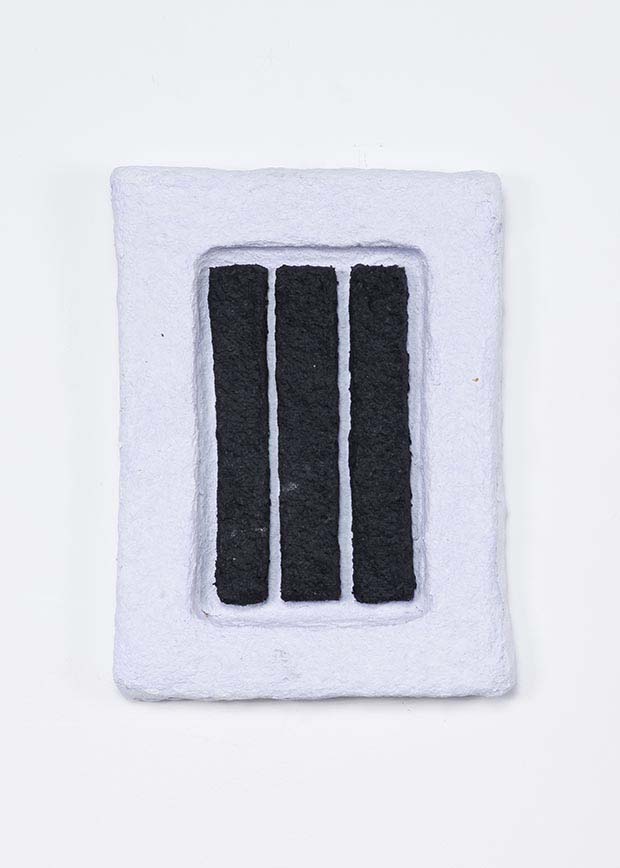 Mohamed Ahmed Ibrahim Three Black Lines, 2016 Sliced cardboard, papier-mache 47 x 35 x 4.5 cm / Courtesy of the artist and Lawrie Shabibi
Mohamed Ahmed Ibrahim Three Black Lines, 2016 Sliced cardboard, papier-mache 47 x 35 x 4.5 cm / Courtesy of the artist and Lawrie Shabibi
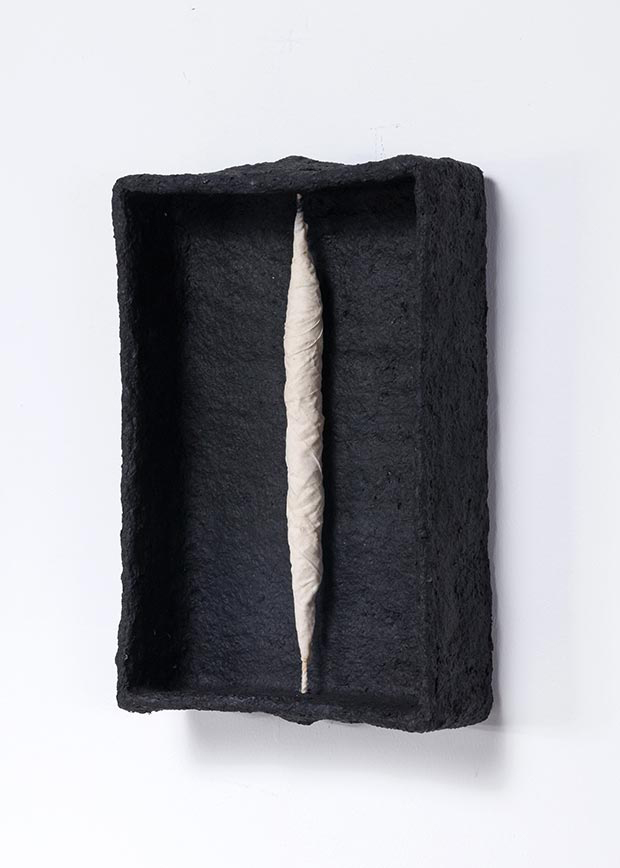 Mohamed Ahmed Ibrahim, Untitled , 2016 Cardboard, papier-mache, twine, tarp 43 x 29 x 10 cm / Courtesy of the artist and Lawrie Shabibi
Mohamed Ahmed Ibrahim, Untitled , 2016 Cardboard, papier-mache, twine, tarp 43 x 29 x 10 cm / Courtesy of the artist and Lawrie Shabibi
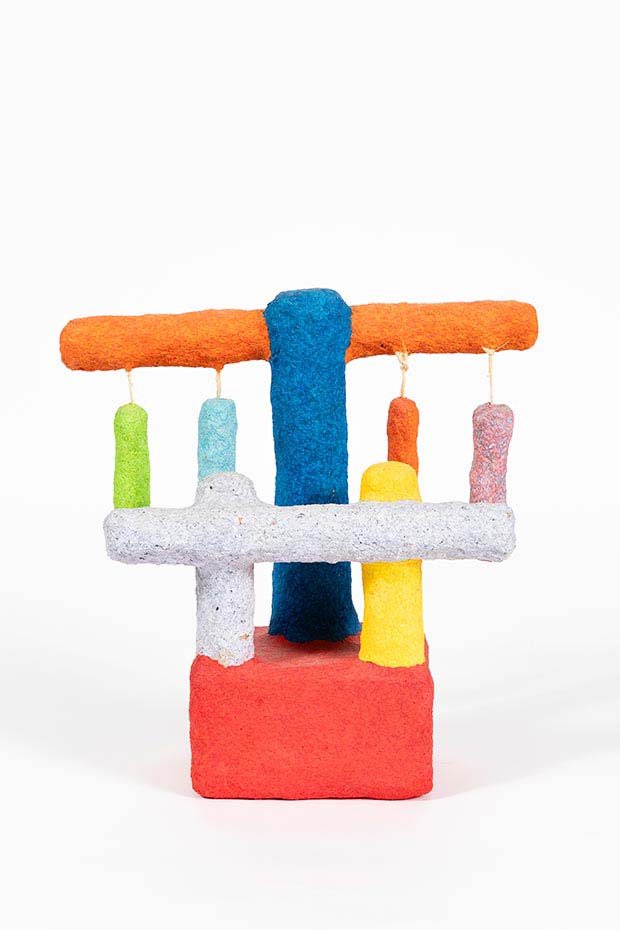 Mohamed Ahmed Ibrahim, Hanging Flowers, 2019 Cardboard, twine, papier-mache 45 x 42 x 15 cm / Courtesy of the artist and Lawrie Shabibi / Photo by Ismael Noor of Seeing things
Mohamed Ahmed Ibrahim, Hanging Flowers, 2019 Cardboard, twine, papier-mache 45 x 42 x 15 cm / Courtesy of the artist and Lawrie Shabibi / Photo by Ismael Noor of Seeing things
Mohamed Ahmed Ibrahim (b. 1962, UAE) is part of the UAE's first generation of contemporary artists from the late 1980s, an avant-garde scene that includes Abdullah Al Saadi, Hussein Sharif, Mohammed Kazem, and the late Hassan Sharif.
Ibrahim is currently representing the United Arab Emirates at the 2022 edition of the Venice Biennale, in an exhibition entitled Between Sunrise and Sunset, curated by Maya Allison (Executive Director of The New York University Abu Dhabi Art Gallery) for the National Pavilion UAE. In March 2018 the Sharjah Art Foundation opened Elements, a survey of works spanning three decades of his practice, curated by Sheikha Hoor Al Qasimi. Other solo exhibitions include Embryonic Coat (2022) at Lawrie Shabibi, Dubai, Dusk Till Dawn (2011) at Cromwell Place London with Lawrie Shabibi, Memory Drum (2020) and The Space between the Eyelid and the Eyeball (2019) at Lawrie Shabibi, Dubai, and a series of solo shows at Cuadro Gallery, Dubai (2018, 2016, 2015, 2013).
Significant group exhibitions include participation in But We Cannot See Them: Tracing a UAE Art Community, 1988-2008 at The NYUAD Art Gallery (2017); The Unbearable Lightness of Being, Yay Gallery, Baku (2015); the Kochi-Muziris Biennale, Kochi (2016); the 53rd Venice Biennale, Venice (2009); the Sharjah Biennial (1993, 2003 and 2007); and the Dhaka Biennial (2002 and 1993). Institutional exhibitions include the Kunstmuseum, Bonn (2005); the Sharjah Art Museum, Sharjah (2005 and 1996), the Ludwig Forum for International Art, Aachen (2002); Institut du Monde Arabe, Paris (1998); Sittard Art Centre, the Netherlands (1995), and the Exhibition for the Emirates Fine Art Society in the Soviet Union, Moscow (1990).
Ibrahim’s public works include Falling Stones Garden (2020), Al Ula, Saudi Arabia, commissioned by the Royal Commission for Al Ula and Desert X; Grocery (2019), Madinat Zayed Market, Abu Dhabi, UAE, commissioned by Ghadan 21, Government of Abu Dhabi as part of the For Abu Dhabi initiative; Untitled (2019), Reem Central Park, Al Reem Island, Abu Dhabi, UAE, commissioned by Aldar Properties PJSC in partnership with Abu Dhabi Art; Kids' Garden (2019), Sheikh Khalifa Medical City, Abu Dhabi, UAE, commissioned by Abu Dhabi Health Services Company; and Bait Al Hurma (2018), Al Mureijah Square, Sharjah, commissioned by the Sharjah Art Foundation as part of the exhibition Elements.
He received the first prize for sculpture at the Sharjah Biennial in 1999 and 2001 and has been a member of the Emirates Fine Arts Society since 1986, founding Art Atelier at the Khor Fakkan Art Centre in 1997. He has participated in artist residencies at Trans Indian Ocean Artist Exchange, Kochi Murzi Biennale, India (2016); A.i.R Dubai (2015); Le Consortium, Dijon, France (2009) and Kunstcentrum Sittard, the Netherlands (1994-1996, 1998-2000). His works have been acquired by significant international collections, including Sharjah Art Foundation, Sharjah; Sharjah Art Museum, Sharjah; Art Jameel Collection, Dubai; Barjeel Art Foundation, Sharjah; Mathaf: Arab Museum of Modern Art, Doha; Kunstcentrum Sittard, Sittard; The British Museum, London; and Le Centre Georges Pompidou, Paris.
He lives and works in Khorfakkan, United Arab Emirates.
Comments
Add a comment
Commenting is not available in this section entry.